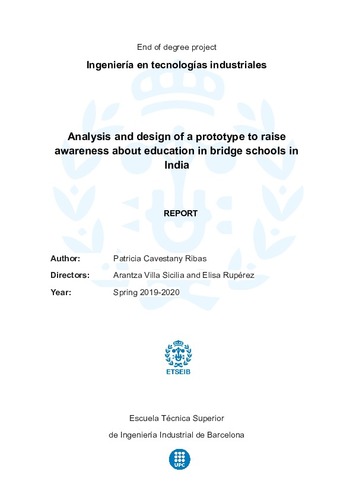Analysis and design of a prototype to raise awareness about education in bridge schools in India

Estadístiques de LA Referencia / Recolecta
Inclou dades d'ús des de 2022
Cita com:
hdl:2117/331814
Tipus de documentTreball Final de Grau
Data2020-07-22
Condicions d'accésAccés obert
Tots els drets reservats. Aquesta obra està protegida pels drets de propietat intel·lectual i
industrial corresponents. Sense perjudici de les exempcions legals existents, queda prohibida la seva
reproducció, distribució, comunicació pública o transformació sense l'autorització del titular dels drets
Abstract
Dirt, no access to electricity nor to clean tap water, dangerous materials, are some of the characteristics of the environments where unfortunately many indian kids grow up. In the face of the incredibly large ratio of poverty that strikes the country, many families live in unbelievable harsh conditions, mostly being slums located in the surroundings of cities. Even if parents work
extremely hard to be able to pursue a better life for their family, in many cases they have to leave their children unattended during long day hours in such hazardous circumstances. Luckily, more and more, enterprises and NGOs are putting their efforts towards granting all kids access to education. Last February, I had the opportunity to travel to Bangalore to participate in a
social innovation camp, which intended to improve education conditions in bridge schools. These infrastructures built by Selco foundation, are portable units that are installed in slums for children to have the opportunity to learn, but also to access a solid meal and hygiene conditions. Seeing that in many cases the fear of leaving their kids in an unknown place to be taken care by exterior teachers, scared parents away taking away with them the opportunity of the youngest ones. As a result, a method to raise awareness about education had to be found so as to familiarize the community of its importance, and that’s when this project was born. After getting to know the context and the nature of the problem, a modular board was designed to tackle this issue. Some research confirms that personalized spaces increases the sense of achievement and belonging as well as the recognition and value of external people. Knowing this, the idea was to build a board, that could be used both in interior and exterior environments, to showcase students’ work all along the week. The object has a system that allows hanging the work but there is also a foldable blackboard that serves as a teaching surface as well as an informational panel. There is also a cover that stops the content from getting damaged, and thanks to its lightness and simple method of use it can be rolled-up for easy transportation and storage. Nevertheless, after a first prototype design many technical aspects needed to be worked on. For this reason, this project contains a material research that finds out that the most suitable components are bamboo, PVC and a combination of cellulose and polyethylene to form the bars, the cover and the main surface respectively. Moreover, to prove that the object met the stiffness and resistance requirements, a stress study is carried out which determines the key dimensions the board needs, to be able to sustain the most extreme situation in which a kid could hang himself from the bar. Finally, since many things had changed from the initial model, the design needed to be optimized and new measurements have been established to better adapt the object to the beneficiaries and the environments conditions. Safety parameters, simple local manufacture, low cost, lightness and minimization of the environmental impact are the main points of study that project entails. All in all, this report contains the all the information regarding this technical thorough research, which has met all the set objectives. The final result leaves us with a practical object that could be
implemented in a near future to make communities realize the importance of education.
TitulacióGRAU EN ENGINYERIA EN TECNOLOGIES INDUSTRIALS (Pla 2010)
| Fitxers | Descripció | Mida | Format | Visualitza |
|---|---|---|---|---|
| memoria-cavestany-patricia.pdf | 3,972Mb | Visualitza/Obre | ||
| anexos-cavestany-patricia.pdf | 1,636Mb | Visualitza/Obre |

